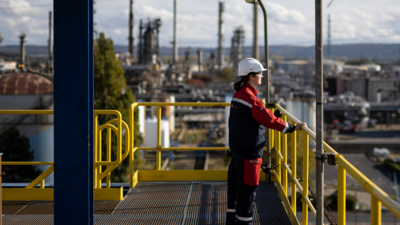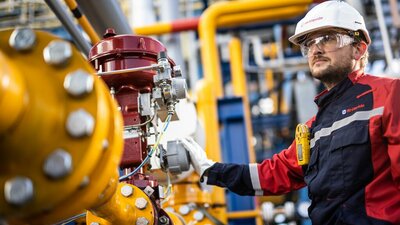In Korea, the country of hydrogen mobility, Air Liquide is engaging in major projects
Published on January 24, 2022

Korea is ranked fifth among the most innovative countries in the world*. Hydrogen mobility plays a big role in this ranking. The country aims to become the world leader in 2040. The country's real strategic goal in the context of energy transition, is where hydrogen drives the Korean economy and mobilizes a number of industrial players. Here, Air Liquide naturally finds its place as a global player in hydrogen. Together with many local partners, the Group is developing the sector across the entire value chain (production, storage, distribution, application) and several large-scale projects. Somie Kim, Vice President Hydrogen Energy of Air Liquide Korea, tells us more.
It’s very simple! The Korean government is actively promoting digital transformation, such as carbon neutrality through eco-friendly policies and expansion of investment in promising industries such as data, network, artificial intelligence, robots and drones.
Yes, absolutely. The hydrogen economy is one of three strategic industries that the Korean government is fostering as future growth engines, and it is also included in the Korea New Deal policy announced in July 2021. Through massive investments and regulatory improvement, the Korean New Deal, aiming to transform the economy to make it greener, with more digital services and stronger safety nets with a total investment of 160 billion euro (220 trillion Korean Won) to create more than 1.9 million jobs by 2025.
In January 2019, the Korean government expressed its vision to become a global leader in hydrogen vehicles and fuel cells by 2040, and announced an ambitious roadmap which outlined the goal of producing 6.2 million fuel cell vehicles and rolling out at least 1,200 hydrogen stations by 2040.
Simply because hydrogen mobility is expected to greatly contribute to reducing greenhouse gases and fine dust!
Air Liquide Korea is well recognized as a great contributor to the development of the hydrogen ecosystem in Korea together with Hyundai Motor, with which we maintain a close partnership. In the downstream market, we are participating in the HyNet Consortium with 13 companies. HyNet aims to build up 100 hydrogen stations for passenger cars by 2022.
Focusing on Heavy Duty market development, in August 2020, we invested in the Incheon Airport Flagship Project and signed a contract for the installation of the largest hydrogen bus station in Korea and a 10-year hydrogen supply contract. And then, in March 2021, we entered into another consortium named KOHYGEN to build hydrogen stations for buses and trucks. KOHYGEN targets to build and operate 300 heavy duty hydrogen stations by 2040. Air Liquide is the only International Gas Company joining these two consortiums in Korea.
Yes. It served as an opportunity to change the dynamics of the hydrogen ecosystem development. After that meeting, President Moon’s cabinet has moved full steam ahead to create a hydrogen ecosystem in Korea. An institutional basis for implementing its ambitious vision was established, such as the enactment of the world's first hydrogen law, the inauguration of the Hydrogen Economy Committee, etc. As a result, South Korea became the world leader for two years in a row in three categories—supply of hydrogen cars, hydrogen refueling stations, and fuel cells, but also exported new products such as hydrogen fuel cell systems for hydrogen trucks and passenger cars, and fuel cells for power generation, laying the foundation for the hydrogen industry to emerge as a promising export industry in the future.
Yes, a lot! Air Liquide signed an agreement to supply key equipment and technology licenses for a 30,000-ton annual production facility for liquid hydrogen, which SK E&S plans to start commercial operation in the second half of 2023. In order to build up hydrogen station infrastructure, Air Liquide Korea is the only industrial gas company participating in both HyNet and KOHYGEN consortiums. In May 2021, a MoU (i.e Memorandum of Understanding) with Lotte Chemicals was signed aiming at investing in a high-pressure hydrogen filling center using a low-carbon hydrogen for the mobility market.
Absolutely. That’s the sense of the MoU we signed with Jeollanam-do Province and Yeosu City for the promotion and development of the hydrogen industry in the region. We plan to further accelerate our investment in building hydrogen value chains in the province, including heavy-duty hydrogen stations, hydrogen filling centers, and liquid hydrogen production facilities.
A total 18,000 hydrogen vehicles, including 120 units of heavy-duty vehicles, are registered in Korea as of October 2021, out of total 24 million vehicles... In the meantime, the government plans to accelerate the heavy-duty market sector, more specifically in Fuel Cell bus markets, targeting the milestone of 3,800 Fuel Cell buses by 2025 and 41,000 by 2040.
The Korean government announced ‘the 9th Electricity Supply & Demand’ in 2020 which plans to increase renewable energy capacity to 77.8 GW by 2034 from 20.1 GW in 2020 mainly with solar and wind power. Considering the power generation fluctuations on solar and wind power, hydrogen production from renewable energy sources is essential.
In order to reach carbon neutrality, the Korean government announced the "2050 Carbon Neutral Scenario" in October 2021. According to the scenario, renewable hydrogen production using water electrolyzers is estimated to be between 3 and 5.5 million tons per year in 2025.
Yes, without a doubt. Korean people are in the early stages of the learning curve. In industrial circles, a lot of companies are recognizing the importance of hydrogen as an essential energy source for the energy transition.
We're focusing on the heavy-duty market development in the mobility market, with high-pressure filling centers and liquid hydrogen investment. In the short-term, we plan to supply gaseous hydrogen with low-carbon targeting the Seoul Metropolitan area. And in the mid-to-long term, we will expand our business through liquid hydrogen investments and accelerate it further with the Group’s innovative solutions.


